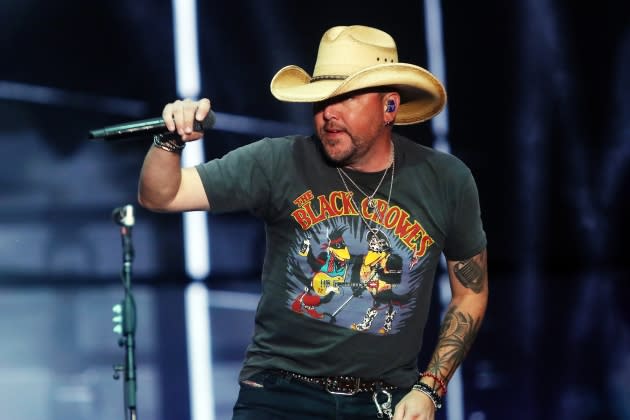Here’s What’s Wrong With Jason Aldean’s Vision of America
- Oops!Something went wrong.Please try again later.

When Dr. Karlos K. Hill first watched Jason Aldean’s video for “Try That in a Small Town,” he saw the current conservative American political moment flash before his eyes. “It’s the narrative of Make America Great Again, of white nationalism,” Hill, a professor of African and African American Studies at the University of Oklahoma, tells Rolling Stone. “But it’s packaged in this really nice, seemingly benign package of country music.”
Aldean released the video for “Try That in a Small Town” last week and, up until then, the single had received little attention or fanfare: It’s been streamed less than five million times on Spotify in the few months since its release. But the reaction to the video was something else.
More from Rolling Stone
Adeem the Artist Satirizes Jason Aldean's 'Try That in a Small Town' With 'Sundown Town'
Conservative Trolls Want to Talk About Rap Music Instead of Jason Aldean. Don't Take the Bait
A Timeline of Jason Aldean's Controversies: Blackface and Confederate Flags
As a greatest-hits reel of Fox News scaremongering imagery flickers by — of protests, police defiance, and urban unrest — the song’s chorus tilts toward a menacing threat of violence: “Try that in a small town,” it warns, “See how far you make it down the road.”
But another detail of the music video is less overt. Along with the stock-footage protest scenes filmed in Canada is a new scene that director Shaun Silva filmed in front of the Columbia, Tennessee, courthouse — the site of the 1927 lynching of Henry Choate. For many, the song’s lyrics, combined with the video’s threatening imagery and filming location, amounted to a suggestion of political violence that was far out of bounds. CMT removed the video from its rotation this week, and Aldean was forced to release a statement defending the song that opened with the words: “In the past 24 hours I have been accused of releasing a pro-lynching song.” (His statement goes on to insist that this interpretation is “meritless.”)
For Dr. Hill, who has written books on the history of lynching, the killing of Emmett Till, and the Tulsa race riots, the video was less a piece of incendiary hate speech than it was an extremely typical piece of conservative culture-war messaging in 2023. Rolling Stone spoke with Dr. Hill about the song, its video, and its hidden message.
What was your first reaction to watching the video to “Try That in a Small Town”?
It was dog-whistle politics at play. There are a couple themes: the idea that rural America is the moral center of America. That’s a very present theme, because you see images of urban America on fire, with protests, but then you have the country music singer placed in the rural area where it’s tranquil and calm and peaceful. You have the rural/urban divide theme, the “rural America is the moral compass” theme, and the “urban America is in chaos” theme.
You also have this veiled threat: “Try that in a small town.” The song is part of the current rhetoric of the moment. The “us versus them, Make America Great Again” idea. You have all of that without the artist even having to touch it. But what’s most concerning is the veiled threats of violence that, given the Jan. 6 attacks, we should be really alarmed by, because we know where they can lead.
Aldean claimed in his statement this week that the song is the opposite: that it’s actually about how everyone needs to come together.
All of what I see and feel is just the conservative narrative of Make America Great Again: “Look at the chaos, the ways America is unraveling. You better not try that transgender stuff in a small town. You better not try that abortion rights stuff in a small town.” That’s the cultural polarization in this country. That’s the irresponsible part. If he was trying to create some sort of anthem to bring people together, he really missed.
Many people have called attention to the fact that the video was partly filmed in front of the Columbia, Tennessee, courthouse.
Obviously there are no references to lynching in the song. I think there are veiled threats of violence, but that would be a stretch, to connect it to the history of lynching. There are actual lynching songs, like songs that are actually about lynching Black people. We can’t equivocate. But, at the same time…someone should have known that there was a possibility that someone would say that.
The last portion of the video shows images of white people and families playing sports and hunting.
After the images of urban unrest and violent protesters, you have the imagery of white men shooting guns. So there’s this real deep insinuation of “We have weapons, you better not try to take our guns.” The imagery is what’s doing all the work. That’s what people are seizing upon. There’s this insinuation that these guns are being used recreationally — but if you “try that in a small town,” then that same mentality will be turned on you.
Best of Rolling Stone